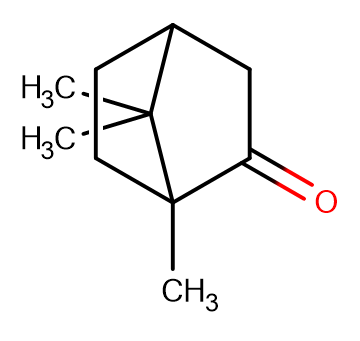
Camphor
CAS No. 76-22-2
Camphor( —— )
Catalog No. M15893 CAS No. 76-22-2
Camphor is a bicyclic monoterpene ketone found widely in plants, especially cinnamomum camphora.
Purity : >98% (HPLC)
 COA
COA
 Datasheet
Datasheet
 HNMR
HNMR
 HPLC
HPLC
 MSDS
MSDS
 Handing Instructions
Handing Instructions
| Size | Price / USD | Stock | Quantity |
| 100MG | 35 | Get Quote |


|
| 500MG | 82 | Get Quote |


|
| 1G | Get Quote | Get Quote |


|
Biological Information
-
Product NameCamphor
-
NoteResearch use only, not for human use.
-
Brief DescriptionCamphor is a bicyclic monoterpene ketone found widely in plants, especially cinnamomum camphora.
-
DescriptionCamphor is a bicyclic monoterpene ketone found widely in plants, especially cinnamomum camphora. It is used topically as a skin antipruritic and as an anti-infective agent.(In Vitro):Camphor induces fibroblast proliferation through the PI3K/AKT and ERK signaling pathways.The MTT assay results show that 32.5, 65, 130, and 260 μM Camphor increase fibroblast viability to 108.9±6.6%, 118.6±2.8%, 127.7±4.2%, and 131.6±7.2%, respectively, compared to 0 μM Camphor treatment.Camphor (0-260 μM) treatment for 24 hours increases the generation of ROS by up to 17.97% compared to 5.04% in the no-treatment control. Camphor (0-260 μM, 24 hours) induces the phosphorylation of PI3K, AKT, ERK, and 4EBP1 in a dose- and time-dependent manner.
-
In VitroCell Viability Assay Cell Line:Primary dermal fibroblast cells Concentration:0-260 μM Incubation Time:24 hours Result:32.5, 65, 130, and 260 μM increased fibroblast viability to 108.9±6.6%, 118.6±2.8%, 127.7±4.2%, and 131.6±7.2%, respectively, compared to 0 μM treatment. Western Blot Analysis Cell Line:Primary dermal fibroblast cells Concentration:0-260 μM Incubation Time:24 hours Result:Induced the phosphorylation of PI3K, AKT, ERK, and 4EBP1, a repressor of mRNA translation and mTOR substrate, in a dose- and time-dependent manner.
-
In Vivo——
-
Synonyms——
-
PathwayOthers
-
TargetOther Targets
-
RecptorOthers
-
Research AreaOther Indications
-
Indication——
Chemical Information
-
CAS Number76-22-2
-
Formula Weight152.24
-
Molecular FormulaC10H16O
-
Purity>98% (HPLC)
-
SolubilityDMSO: 10 mM
-
SMILESCC1(C)C2CCC1(C)C(=O)C2
-
Chemical Name——
Shipping & Storage Information
-
Storage(-20℃)
-
ShippingWith Ice Pack
-
Stability≥ 2 years
Reference
1.Willetts A, Kelly DR. Microbiology. 2014 Aug;160(Pt 8):1783-94.
molnova catalog



related products
-
Peucenidin
Peucenidin is a natural product for research related to life sciences.
-
ETHYL 3,5-DIHYDROXYB...
ETHYL 3,5-DIHYDROXYBENZOATE is a natural product.?It inhibits human carbonic anhydrase 2.
-
Histatin 3 (H3)
Histatin 3 (H3)



 Cart
Cart
 sales@molnova.com
sales@molnova.com


